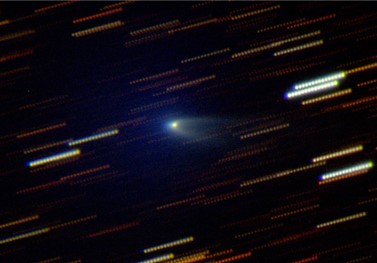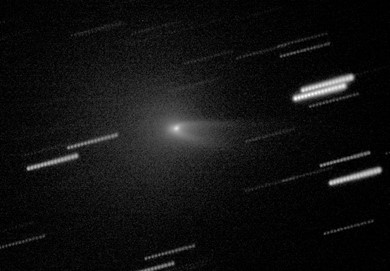-
Faulkes Telescope Project Privacy Policy
Colour Imaging of a Comet using the New MuSCAT3 Camera on FTN
By Richard Miles
Background
The STFC-funded ‘Comet Chasers’ project has recently started working with several primary schools across Wales, led by Helen Usher (FT/Open University) working with experienced comet-watchers Tony Angel and Richard Miles (British Astronomical Association). Here, Richard reports on the first colour image of a comet, obtained with the new MuSCAT3 camera installed on FTN.
Comet Pons-Winnecke was originally discovered by the prolific comet hunter, J.-L. Pons from Marseille in 1819 and was later rediscovered by F. Winnecke from Bonn in 1858, hence its double-barrelled name. Now catalogued as Comet 7P, it orbits the Sun every 6.36 years and is currently heading towards its 1.23 AU perihelion, which it will reach on May 27. It is the most favoured target for the ‘Comet Chasers’ group in the coming weeks and so images were obtained during a Real-Time Interface (RTI) session using the FT North equipped with the new MuSCAT3 camera to ascertain the general appearance and brightness of the comet.
Imaging Comet 7P
The comet was moving quite rapidly at the time (April 23) being just 0.63 AU from Earth and having just passed from the constellation of Ophiuchus into Aquila and lying within the Milky Way. In fact, the comet was less than 1° from the galactic equator and normally would have been seen framed against a dense star field but on this occasion, the comet was seen in front of a relatively dusty region that obscured more distant stars. We were lucky!
A total of 15 40-second exposures were made with MuSCAT3 yielding 3 sets of images in g’, r’ and i’ passbands. Each set was analysed using Astrometrica software, tracking and stacking the images on the apparent motion of the comet (2.19”/min in p.a. 105°). The stacked images were then cropped and combined to create an RGB colour image using Fitswork software and shown in Figure 1. Note the faint stars in Figure 1 are highly reddened due to interstellar absorption by intervening molecular clouds.

As you can see in Figure 1, the comet appears rather unusual in having a bifurcated tail like two curved prongs, which are leaving the nucleus in both the northerly and southerly directions. These may be the result of dust and gas escaping from the end regions of an elongated or bi-lobal nucleus. The tail appears to be rather neutral grey in colour whereas the light ahead of the nucleus is distinctly blue.
Figure 2, was taken via the g’ passband which comprises only the blue and green light. Here you can see a near-spherical halo of light measuring about 3’ across and displaced ahead of the nucleus in the direction of the Sun. This light is due to emission lines from gases such as H2O arising from the sublimation of ices exposed to the heat of the Sun on the daytime side of the nucleus.

What’s next?
We are hoping that Comet Chasers will be able to follow the development of the comet’s tail during the coming few months. Their observations may reveal changes in the tail caused by the rotation of the nucleus.
Stay tuned!
